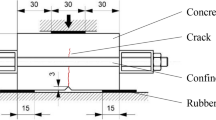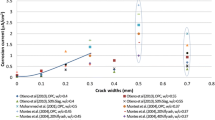Abstract
Crack provokes to lose a main performance of watertightness of concrete and leads to accelerate the deterioration of concrete. This brings about reduction of service life of concrete eventually. The background is a good motivation to define a critical crack width to prevent chloride from penetrating through crack in concrete. Since concrete structures have to be proven for a minimum service life, the critical crack width can be regarded as a crucial factor for estimating durability performance and integrity of concrete structures. This study is focused on examining the effect of micro-crack on chloride penetration in concrete and identifying the critical crack width experimentally. Because concrete structures have to meet a minimum service life, crack width must be smaller than the critical crack width. Specimens with different crack width have been subjected to Rapid Chloride Migration testing (RCM). The results of this study show the critical crack width of about 0.013 mm. Cracks smaller than the critical crack width are considered not to have a significant influence on the rate of chloride penetration inwards, while chloride penetration does proceed faster above this critical crack width. Meanwhile, cracked specimens were immersed in artificial seawater for 472 days. The result of this long term experiment indicates critical crack width of 0.04 mm. It is thought that crack healing leads the difference between short and long tem experiment.
Similar content being viewed by others
References
ACI Committee 224 (1999). Control of cracking in concrete structures (ACI 224R-90), ACI Manual of Concrete Practice, Part 3, ACI.
ACI Committee 318 (1999). Building code requirement for reinforced Concrete (ACI 318-89), Section 10.6, ACI.
Aldea, C. M. and Shah, S. P. (1999). “Effect of cracking on water and chloride permeability of concrete.” Journal of Materials in Civil Engineering, ASCE, Vol. 11, No. 3, pp. 181–187.
British Standards Institution (1992). ENV 1991-1-1, BSI, London.
British Standards Institution (1997). BS 8110: Part.1, BSI, London.
CEB (1985). CEB manual, Cracking and Deformations.
Federation Internationale de la Precontrainte (1990). CEB-FIP model code, Thomas Telford, London.
Francois, R., and Arliguie, G. (1999). “Effect of microcracking and cracking on the development of corrosion in reinforced concrete members.” Magazine of Concrete Research, Vol. 51, No. 2, pp. 143–150.
Gale, J. E. (1987). “Comparison of coupled fracture deformation and fluid flow models with direct measurement of fracture pore structure and stress-flow properties.” Proceedings of the 28 th U.S. Symposium on Rock Mechanics in Tucson, Arizona, AA. Balkema (Eds.), pp. 1213–1222.
Gowripalan, N., Sirivivatnanon, V., and Lim, C. C. (2000). “Chloride diffusivity of concrete cracked in flexure.” Cement and Concrete Research, Vol. 30, No. 5, pp. 725–730.
Ismail, M., Toumi, A., François, R., and Gagné, R. (2004) “Effect of crack opening on the local diffusion of chloride in inert materials.” Cement and Concrete Research, Vol. 34, No. 4, pp. 711–716.
Kato, E., Kato, Y., and Uomoto, T. (2005). “Development of simulation model of chloride ion transportation in cracked concrete.” Journal of Advanced Concrete Technology, JCI, Vol. 3, No. 1, pp. 85–94.
Li, C. Q. (2002). “Initiation of chloride-induced reinforcement corrosion in concrete structural members-prediction.” ACI Structural Journal, Vol. 99, No. 2, pp. 131–141.
Locoge, P., Massat, M., Oliver, J.-P., and Richet, C. (1992). “Ion diffusion in microcracked concrete,” Cement and Concrete Research, Vol. 22, No. 1992, pp. 431–438.
Mehta, P. K. and Monteiro, P. J. M. (2006). Concrete: Structure, properties and materials, Third Edition, McGraw-Hill.
Mivelaz, P. (1996). Estanchéité des tructures en béton armé, fuites au travers d’un élément fissuré, PhD Thesis, EPFL, No. 153.
Mohammed, T. U., Otsuki, N., Hisada, M., and Shibata, T. (2001). “Effect of crack width and bar types on corrosion of steel in concrete.” Journal of Materials Journal in Civil Engineering, ASCE, Vol. 13, No. 2, pp. 194–201.
NT-Build 492 (1999). Concrete, mortar and cement-based repair materials: Chloride migration coefficient from non-steady-state migration experiment, Finland.
Reinhardt, H. W., Sosoro, M., and Zhu, X. (1998). “Cracked and repaired concrete subjected to fluid penetration.” Materials and Structures, Vol. 31, No. 205, pp. 74–83.
RILEM Report 16 (1997). Penetration and permeability of concrete: Barriers to organic and contaminating liquids, Reinhardt, H.W. (Eds.), E & FN Spon.
Samaha, H. R. and Hover, K. C. (1992). “Influencing of micro-cracking on the mass transport properties of concrete.” ACI Materials Journal, Vol. 89, No. 4, pp. 416–424.
Schiessl, P. (1975). “Admissible crack width in reinforced concrete structures.” Inter-association Colloquium on the Behavior in Service of Concrete Structures. Preliminary Reports II, Liege, pp. 739–755.
Tongnazzi, C., Ollivier, J. P., Carcasses M., and Torrenti, J. M. (1998). “Couplage fissuration-dégradation chimique des matériaux cimentaires: Premiers résultats sur les propriétés de transfert.” Ouvrages, Géomarériaux et Interactions, Ch. Petit, G. Pijaudier-Cabot and J. M. Reynouard (Eds.), Hermès, Paris, pp. 69–84.
TRB-AHD45 (2005). “The effect of cracking in high performance concretes on reinforcement corrosion and structural durability.” Transport Research Board, RPS-AHD45-2005-01.
Author information
Authors and Affiliations
Corresponding author
Rights and permissions
About this article
Cite this article
Yoon, IS., Schlangen, E. Experimental examination on chloride penetration through micro-crack in concrete. KSCE J Civ Eng 18, 188–198 (2014). https://doi.org/10.1007/s12205-014-0196-9
Received:
Revised:
Accepted:
Published:
Issue Date:
DOI: https://doi.org/10.1007/s12205-014-0196-9




